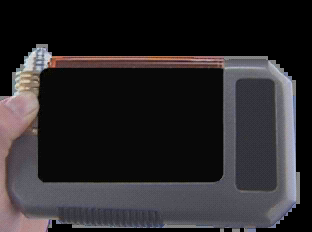As you can guess from the title NihAV got some support for Duck formats, namely TrueMotion 1 and TrueMotion RT. The implementation was rather straightforward except that it took some additional work to support 16-bit video buffers.
Of course I made sure my new TM1 decoder supports decoding sprites. Here’s an example of such sprite picture:

The hardest part was finding a sample.
I can’t sanely support transparency though since it uses 6-bit alpha with RGB555 image and while I can support such format quite easily I’d rather not.
If you wonder about the details of sprite support, it’s almost the same as ordinary inter-coded 16-bit TM1 with some nuances:
- frame header has additional 16-bit fields for sprite position and size (and actual sprite size is used in the decoding—the result is supposed to be put over the destination picture);
- sprite has twice as much mask bits as inter frame—two per 4×4 block (LSB first as usual). Bits
00 mean the next four pixels should be skipped (and predictor reset to zero), bits 01 mean it’s opaque sprite data and bits 10 mean it’s sprite data with transparency info present;
- sprite data is decoded as standard 4×4 TM1 block data (i.e. on C delta per 4×4 block) except that in transparency mode it also reads transparency data after each pixel pair.
That information comes from our old trusty source of information called VPVision source code dump (which was used to understand TrueMotion 1, 2 and probably DK3/DK4 ADPCM (and maybe VP3 but I’m not sure at all). Also it turns out to contain TrueMotion RT encoder source code as well (which could be used to reconstruct the decoder but I forgot about it at the time and used the binary specification instead).
And now I’d like to talk about Duck codecs in general.
The codecs from this family can be divided into three groups:
- The Age of Darkness: the original TrueMotion codec and its evolution plus related ADPCM codecs;
- The Age of Enlightenment: game codecs evolving into more generic video codecs and using more mainstream codec design (DCT-based, many ideas borrowed from H.263 and H.264) plus AVC (that’s audio codec if you don’t remember);
- The Age of
EA Guardian: the codecs produced after Duck was bought by certain company.
The Age of Darkness codecs
Those codecs were used mostly in video games but TM1 was also licensed to Horizons Technology.
The idea behind TM1 is very simple: you split video into 4×4 blocks, predict each pixel from top and pack using quantised deltas and fixed codebook looking more like Tunstall codes (i.e. output code is always a fixed length of one byte but it may correspond to a variable length sequence of input codes). Also depending on quality frame blocks have different number of colour difference deltas per block (1, 2 or 4).
TrueMotion RT is an adaptation of TM1 for real-time video capturing (hence the name). In this case video is coded as planar YUV410 using fixed set of deltas with index taking 2, 3 or 4 bits. But the general coding idea (top and left prediction, delta quantisation and coding its index) remains the same. It uses the same frame header obfuscation so it’s probably an elder sibling of TrueMotion 2 (and its name is more like TrueMotion RT version 2.0 and not TrueMotion 2 RT but the details are unclear). There are different versions of the codec, for example Star Control II: The Ur-Quan Masters on 3DO used a special TM1 format split into several files: .hdr for global information (including quantised delta sets), .tbl with codebook definition, .duk with actual frame data and .frm with the frame offsets for .duk file. It’s a pity I can’t support it without very special handling.
TrueMotion 2 gets rid of single static codebook and packs appropriate data (deltas for different-resolution blocks, motion vector data, actual block types etc etc) in separate segments with their own Huffman codes. There are many improvements but the codec still operates on 4×4 blocks with horizontal and vertical prediction of each symbol.
There is not much known about TrueMotion 2X but so far it looks like maybe slightly improved TM2. Hopefully it will be clearer if I manage to implement a decoder for it.
And finally there were two simple ADPCM codecs accompanying video (usually TM2), there’s nothing much to say about those.
The Age of Enlightenment codecs
This was the age when Duck codecs became widely known and accepted, when various companies licensed them for their own needs and when it was really the golden age for them.
It all starts with TrueMotion VP3 that set the standard for the following codecs. It employed the a bit non-standard 8×8 DCT, referencing last intra frame as an alternative to referencing just the previous frame (later knows as golden frame), with various types of information grouped together instead of interleaving it all, and with coefficients coded as tokens (EOB, zero run, plus-minus one, plus-minus two, large coefficient token and such). The same approach would be used for subsequent codecs as well. Of course it briefly enjoyed the renaissance when Duck decided to put it into open-source and Xiph Theora was created on its base (and since there were no other free and open-source video codec alternatives it was destined to have popularity and success before something better comes).
TrueMotion VP4 was mostly the same but with different coding method for some data types. Maybe it was the first codec to move edge loop filtering from being performed on the frame to being performed on temporary block used in motion compensation but I’m not entirely sure.
TrueCast VP5 was the first in the series to employ their own version of static binary arithmetic coder mostly known as bool coder. That means that instead of updating bit probability after each decoding using that context as CABAC does, frame header encodes fixed probabilities (or just updates from the probabilities in the previous frame) and uses them for decoding.
VP6. Probably the most famous of them all since it was used in Flash videos. From technical point of view it’s just small improvement in some details over VP5. I suspect this was the first codec in the series that introduced selecting random frame as the next golden frame (previously it was just last intra frame, now any inter frame can signal that it should become golden).
VP7. This is the first installation in the series that was based on H.264 ideas like 4×4 transform and spatial prediction.
And of course there’s AVS, an audio codec inspired by AAC LC that accompanied some VP5-VP7 videos.
The Age of Guardian codecs
While the design direction has not changed much, the codecs themselves mostly belong to the niche provided by their current owner and hardly used anywhere else. For now we have VP8, VP9 and VP10 (aka AV1).
I hope there will be more to write about those after I write decoders for the rest of them and learn the shameful details of their design in the process.

